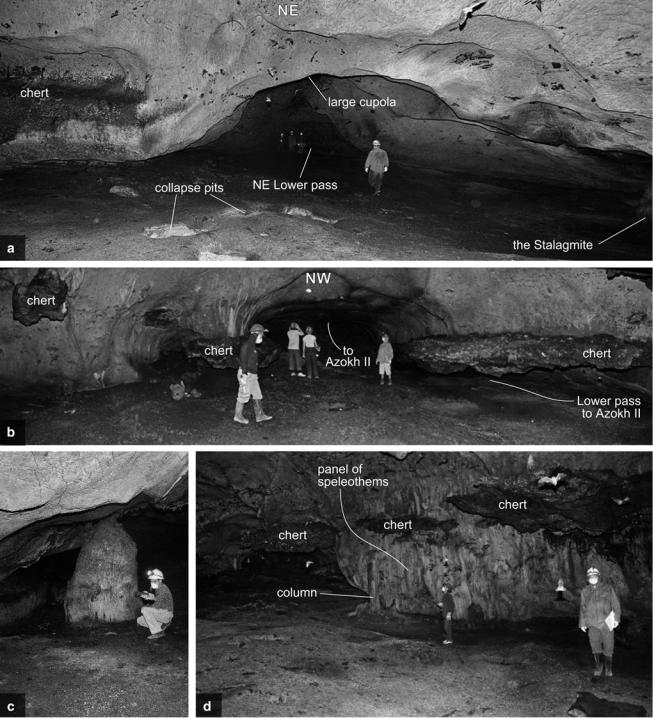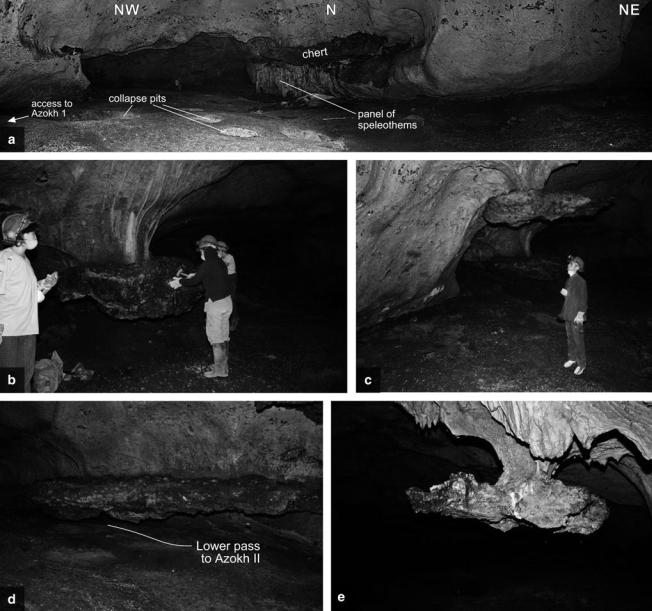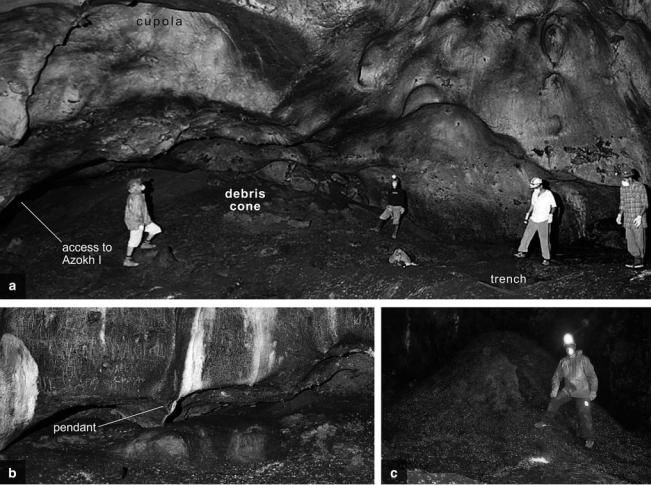
- •Preface
- •Contents
- •Contributors
- •1 Introduction: Azokh Cave and the Transcaucasian Corridor
- •Abstract
- •Introduction
- •History of Excavations at Azokh Caves
- •Excavations 1960–1988
- •Excavations 2002–2009
- •Field Seasons
- •2002 (23rd August–19th September)
- •2003 (4th–31st August)
- •2004 (28th July–6th August)
- •2005 (26th July–12th August)
- •2006 (30th July–23rd August)
- •2007 (9th July–4th August)
- •2008 (8th July–14th August)
- •2009 (17th July–12th August)
- •Correlating Huseinov’s Layers to Our Units
- •Chapters of This Book
- •Acknowledgments
- •References
- •Abstract
- •Introduction
- •Azokh 1
- •Sediment Sequence 1
- •Sediment Sequence 2
- •Discussion on the Stratigraphy of Azokh 1
- •Azokh 2
- •Azokh 5
- •Discussion on the Stratigraphy of Azokh 5
- •Conclusions
- •Acknowledgments
- •References
- •3 Geology and Geomorphology of Azokh Caves
- •Abstract
- •Introduction
- •Geological Background
- •Geomorphology of Azokh Cave
- •Results of the Topographic Survey
- •Azokh 1: Main Entrance Passageway
- •Azokh 2, 3 and 4: Blind Passages
- •Azokh 5: A Recently Discovered Connection to the Inner Chambers
- •Azokh 6: Vacas Passageway
- •Azokh I: The Stalagmite Gallery
- •Azokh II: The Sugar-Mound Gallery
- •Azokh III: The Apron Gallery
- •Azokh IV: The Hall Gallery
- •Results of the Geophysical Survey
- •Discussion
- •Conclusions
- •Acknowledgments
- •References
- •4 Lithic Assemblages Recovered from Azokh 1
- •Abstract
- •Introduction
- •Methods of Analysis
- •Results
- •Unit Vm: Lithic Assemblage
- •Unit III: Lithic Assemblage
- •Unit II: Lithic Assemblage
- •Post-Depositional Evidence
- •Discussion of the Lithic Assemblages
- •Comparison of Assemblages from the Earlier and Current Excavations
- •Chronology
- •Conclusions
- •Acknowledgements
- •References
- •5 Azokh Cave Hominin Remains
- •Abstract
- •Introduction
- •Hominin Mandibular Fragment from Azokh 1
- •Discussion of Early Work on the Azokh Mandible
- •New Assessment of the Azokh Mandibular Remains Based on a Replica of the Specimen
- •Discussion, Azokh Mandible
- •Neanderthal Remains from Azokh 1
- •Description of the Isolated Tooth from Azokh Cave (E52-no. 69)
- •Hominin Remains from Azokh 2
- •Human Remains from Azokh 5
- •Conclusions
- •Acknowledgements
- •References
- •6 The New Material of Large Mammals from Azokh and Comments on the Older Collections
- •Abstract
- •Introduction
- •Materials and Methods
- •General Discussion and Conclusions
- •Acknowledgements
- •References
- •7 Rodents, Lagomorphs and Insectivores from Azokh Cave
- •Abstract
- •Introduction
- •Materials and Methods
- •Results
- •Unit Vm
- •Unit Vu
- •Unit III
- •Unit II
- •Unit I
- •Discussion
- •Conclusions
- •Acknowledgments
- •8 Bats from Azokh Caves
- •Abstract
- •Introduction
- •Materials and Methods
- •Results
- •Discussion
- •Conclusions
- •Acknowledgements
- •References
- •9 Amphibians and Squamate Reptiles from Azokh 1
- •Abstract
- •Introduction
- •Materials and Methods
- •Systematic Descriptions
- •Paleobiogeographical Data
- •Conclusions
- •Acknowledgements
- •References
- •10 Taphonomy and Site Formation of Azokh 1
- •Abstract
- •Introduction
- •Taphonomic Agents
- •Materials and Methods
- •Shape, Size and Fracture
- •Surface Modification Related to Breakage
- •Tool-Induced Surface Modifications
- •Tooth Marks
- •Other Surface Modifications
- •Histology
- •Results
- •Skeletal Element Representation
- •Fossil Size, Shape and Density
- •Surface Modifications
- •Discussion
- •Presence of Humans in Azokh 1 Cave
- •Carnivore Damage
- •Post-Depositional Damage
- •Acknowledgements
- •Supplementary Information
- •References
- •11 Bone Diagenesis at Azokh Caves
- •Abstract
- •Introduction
- •Porosity as a Diagenetic Indicator
- •Bone Diagenesis at Azokh Caves
- •Materials Analyzed
- •Methods
- •Diagenetic Parameters
- •% ‘Collagen’
- •Results and Discussion
- •Azokh 1 Units II–III
- •Azokh 1 Unit Vm
- •Azokh 2
- •Prospects for Molecular Preservation
- •Conclusions
- •Acknowledgements
- •References
- •12 Coprolites, Paleogenomics and Bone Content Analysis
- •Abstract
- •Introduction
- •Materials and Methods
- •Coprolite/Scat Morphometry
- •Bone Observations
- •Chemical Analysis of the Coprolites
- •Paleogenetics and Paleogenomics
- •Results
- •Bone and Coprolite Morphometry
- •Paleogenetic Analysis of the Coprolite
- •Discussion
- •Bone and Coprolite Morphometry
- •Chemical Analyses of the Coprolites
- •Conclusions
- •Acknowledgements
- •References
- •13 Palaeoenvironmental Context of Coprolites and Plant Microfossils from Unit II. Azokh 1
- •Abstract
- •Introduction
- •Environment Around the Cave
- •Materials and Methods
- •Pollen, Phytolith and Diatom Extraction
- •Criteria for the Identification of Phytolith Types
- •Results
- •Diatoms
- •Phytoliths
- •Pollen and Other Microfossils
- •Discussion
- •Conclusions
- •Acknowledgments
- •References
- •14 Charcoal Remains from Azokh 1 Cave: Preliminary Results
- •Abstract
- •Introduction
- •Materials and Methods
- •Results
- •Conclusions
- •Acknowledgments
- •References
- •15 Paleoecology of Azokh 1
- •Abstract
- •Introduction
- •Materials and Methods
- •Habitat Weightings
- •Calculation of Taxonomic Habitat Index (THI)
- •Faunal Bias
- •Results
- •Taphonomy
- •Paleoecology
- •Discussion
- •Evidence for Woodland
- •Evidence for Steppe
- •Conclusions
- •Acknowledgments
- •Species List Tables
- •References
- •16 Appendix: Dating Methods Applied to Azokh Cave Sites
- •Abstract
- •Radiocarbon
- •Uranium Series
- •Amino-acid Racemization
- •Radiocarbon Dating of Samples from the Azokh Cave Complex (Peter Ditchfield)
- •Pretreatment and Measurement
- •Calibration
- •Results and Discussion
- •Introduction
- •Material and Methods
- •Results
- •Conclusions
- •Introduction
- •Laser-ablation Pre-screening
- •Sample Preparation and Measurement
- •Results
- •Conclusions
- •References
- •Index

68 |
P. Domínguez-Alonso et al. |
Fig. 3.11 Entrance to Azokh 2, photographed in 2004. Geology hammer and rucksack for scale
Fig. 3.12 Azokh 5 entrance. a Original (undisturbed) level of sediment fill in the passage just after the first survey was completed of the interior. Hammer (circled) for scale; b Early survey work being conducted through Azokh 5 passage, viewed from the interior
name from the Spanish word for cows – local livestock commonly frequent the entranceway and their dung may be thickly deposited underfoot. This narrow passage is about 12 m long (with a surface area of 7 m2) and it rises upwards on entering the cave interior, before connecting with Azokh IV chamber inside.
Azokh I: The Stalagmite Gallery
With a total surface area of 843.5 m2 the Stalagmite Gallery is the largest inner chamber of the cave system at Azokh (Figs. 3.13 and 3.14; see also Fig. 3.8 for general location). The name was originally coined by the previous excavation

3 Geology and Geomorphology of Azokh Caves |
69 |
Fig. 3.13 Azokh I [The Stalagmite Gallery: Part 1]. a View of the NE branch of this gallery, as seen from the entrance passage. At the far end of the field of view are a lower pass and a high cupola. A large conspicuous stalagmite, which gives the gallery its name, is located at the extreme right of this image (along the SE wall of the chamber); b The termination of the NW branch of this gallery, leading into the second gallery (Azokh II). Note the thick bands of chert, which are laterally persistent for several meters, forming cornices; c The stalagmite; d The largest known panel of speleothems in the cave system, protected from corrosion by overlying chert cornices. This panel includes flags and a c. 2 m high column

70 |
P. Domínguez-Alonso et al. |
Fig. 3.14 Azokh I [The Stalagmite Gallery: Part 2]. a General panorama of the gallery from entrance passage from Azokh 1; b–e Detailed views of some hanging chert blocks, pendants and cornices. b Pedicled hanging block of chert; c View showing the spatial relationship of the hanging blocks in (b) and (e); d Large chert cornice with the lower pass to Azokh II: note the gentle slope of the ground surface; e Pedicled hanging block of chert. This structure is very narrow and the pendants in front of it (which are not stalactites) provide evidence of appreciable corrosion of the cave walls (probably by condensation-corrosion processes)
team (Huseinov 1985) in reference to the large conspicuous stalagmite found along the SE wall of the chamber (Fig. 3.13c), a short distance from the narrow connecting passage to Azokh 1.
The Azokh I chamber divides into two branches (Fig. 3.8), as follows:
•
distinctive inflection in the cave ceiling and the ground slopes slightly distally. This lower part of the gallery (overlain by the low ceiling) has a surface area of 38 m2. The ground surface of the crawling pass is composed of loose sediment, most of which is completely undisturbed.
•Branch 2 opens towards the left hand side (NW) as one enters from Azokh 1 passage and continues for some 47 m in a northwesterly direction (i.e. orthogonal to the first branch), before connecting with the next inner

3 Geology and Geomorphology of Azokh Caves |
71 |
chamber (Azokh II). There is a steady slope on the floor of this gallery, ascending 8 m elevation in less than 23 m. The NW end of this chamber ends with a large chert cornice on the northern wall (Fig. 3.13b). A second (lower-level) access route to Azokh II is present below this feature (Figs. 3.13b and 3.14d).
The limestone walls of the Stalagmite Gallery are mostly light in color, with broad and shallow concave surface depressions. In the northern wall of Branch 2 a large band of overhanging chert is located at about 2.5 m above ground level. This is a common place for bats to congregate and, as a result, a half meter thick mound of guano has developed beneath it. This block of chert also protects parts of several speleothems covering the wall from corrosion. This panel of speleothems is about 3 m long and 2.5 m high, and stalactites, flags and a 2 m high column are present (Figs. 3.13d and 3.14a).
Very close to the walking passage connecting through to Azokh II, a large block of chert hangs from the ceiling via a
narrow pedicle of limestone (Fig. 3.14e). This feature provides evidence for the intense corrosion of the cave walls during the late evolution of the karst system. A short distance beyond this (Fig. 3.14c), is another large block of chert hanging from the ceiling at waist level (Fig. 3.14b). It is less obvious, due in part to its close proximity to a large underlying debris cone of sediment (from a collapsed gallery).
The ground sediment in the Azokh I chamber is a sandy-clay, with a thin veneer of more clay-rich material. During the summer months, when excavation and survey work is in progress, this sediment is usually found to be slightly damp. The access route to Azokh II was dry during a visit made by PDA in November 2007. The ceiling in this part of the cave used to have a few thin straw stalactites, which were fairly recent in age and active during the summer. The debris of a large collapsed chamber is located nearby (Fig. 3.8) and possibly acts as a water reservoir for this feature. Several meter-scale depressions occur on the
Fig. 3.15 Azokh II [The Sugar-mound Gallery]. a General panorama of the southwestern part of this cave gallery. A boulder choke and resultant debris cone blocks access to it from the upper pit over Azokh 2 on the exterior (see Fig. 3.8). b The NW wall of the gallery, composed largely of pendants; c Very large pile of bat guano present inside the chamber. The gallery is named after this feature
